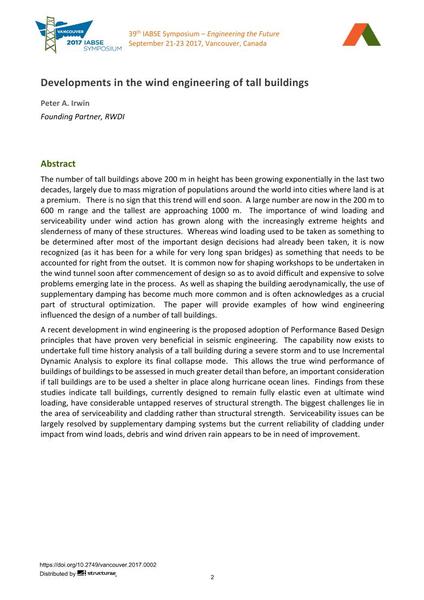Developments in the wind engineering of tall buildings

| Autor(en): |
Peter A. Irwin
(Founding Partner, RWDI)
|
|---|---|
| Medium: | Tagungsbeitrag |
| Sprache(n): | Englisch |
| Tagung: | IABSE Symposium: Engineering the Future, Vancouver, Canada, 21-23 September 2017 |
| Veröffentlicht in: | IABSE Symposium Vancouver 2017 |
| Seite(n): | 2 |
| Jahr: | 2017 |
| DOI: | 10.2749/vancouver.2017.0002 |
| Abstrakt: |
The number of tall buildings above 200 m in height has been growing exponentially in the last two decades, largely due to mass migration of populations around the world into cities where land is at a premium. There is no sign that this trend will end soon. A large number are now in the 200 m to 600 m range and the tallest are approaching 1000 m. The importance of wind loading and serviceability under wind action has grown along with the increasingly extreme heights and slenderness of many of these structures. Whereas wind loading used to be taken as something to be determined after most of the important design decisions had already been taken, it is now recognized (as it has been for a while for very long span bridges) as something that needs to be accounted for right from the outset. It is common now for shaping workshops to be undertaken in the wind tunnel soon after commencement of design so as to avoid difficult and expensive to solve problems emerging late in the process. As well as shaping the building aerodynamically, the use of supplementary damping has become much more common and is often acknowledges as a crucial part of structural optimization. The paper will provide examples of how wind engineering influenced the design of a number of tall buildings. A recent development in wind engineering is the proposed adoption of Performance Based Design principles that have proven very beneficial in seismic engineering. The capability now exists to undertake full time history analysis of a tall building during a severe storm and to use Incremental Dynamic Analysis to explore its final collapse mode. This allows the true wind performance of buildings of buildings to be assessed in much greater detail than before, an important consideration if tall buildings are to be used a shelter in place along hurricane ocean lines. Findings from these studies indicate tall buildings, currently designed to remain fully elastic even at ultimate wind loading, have considerable untapped reserves of structural strength. The biggest challenges lie in the area of serviceability and cladding rather than structural strength. Serviceability issues can be largely resolved by supplementary damping systems but the current reliability of cladding under impact from wind loads, debris and wind driven rain appears to be in need of improvement. |
0.18 MB
- Über diese
Datenseite - Reference-ID
10298602 - Veröffentlicht am:
02.02.2019 - Geändert am:
21.05.2021



